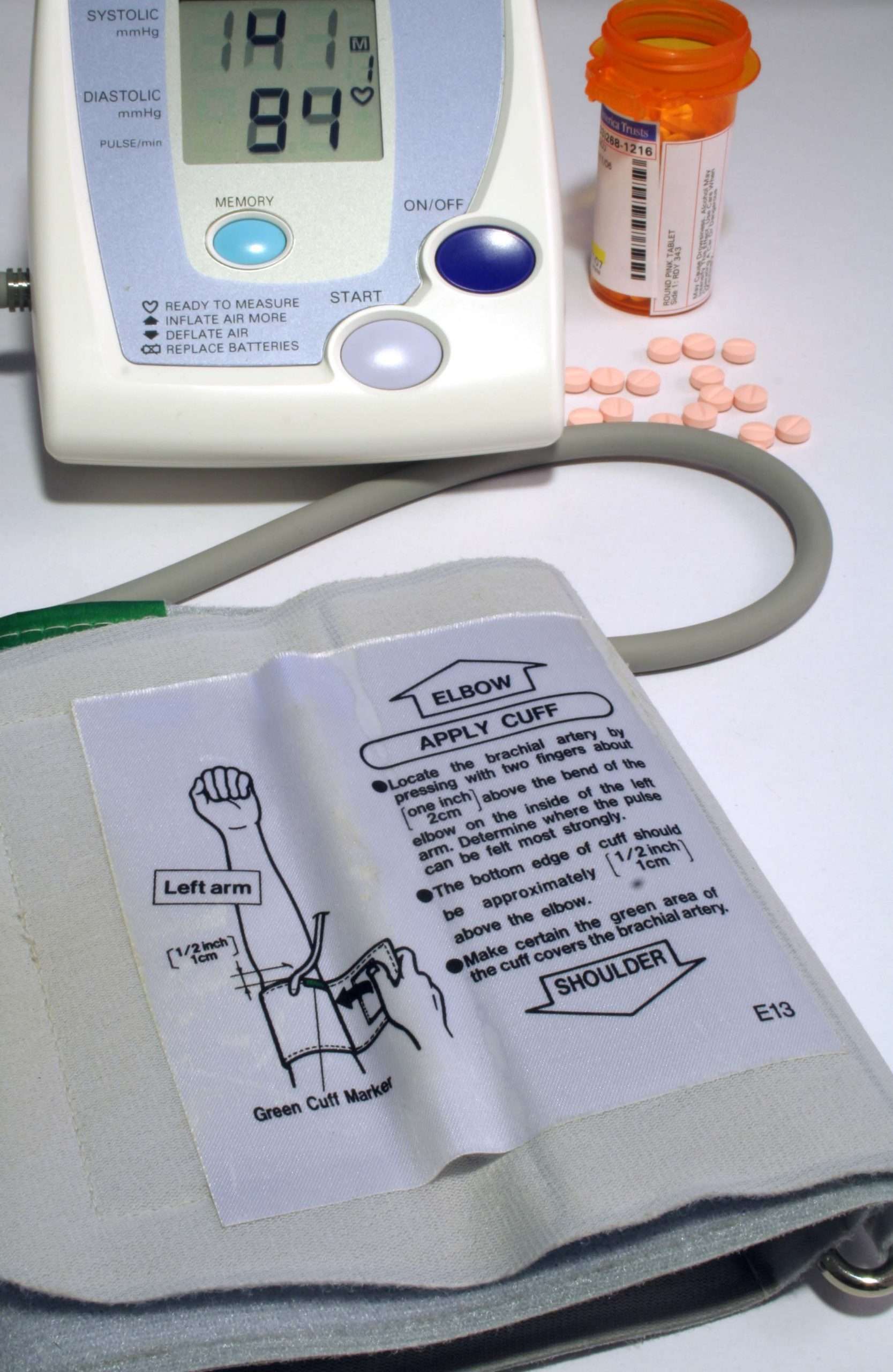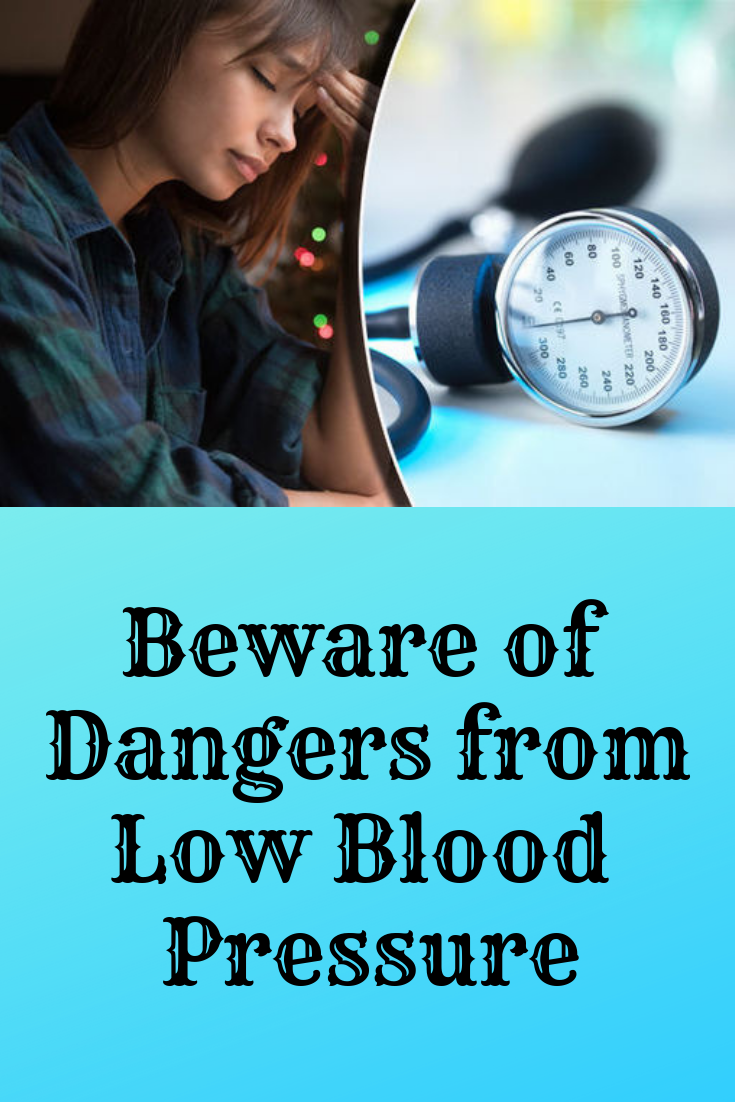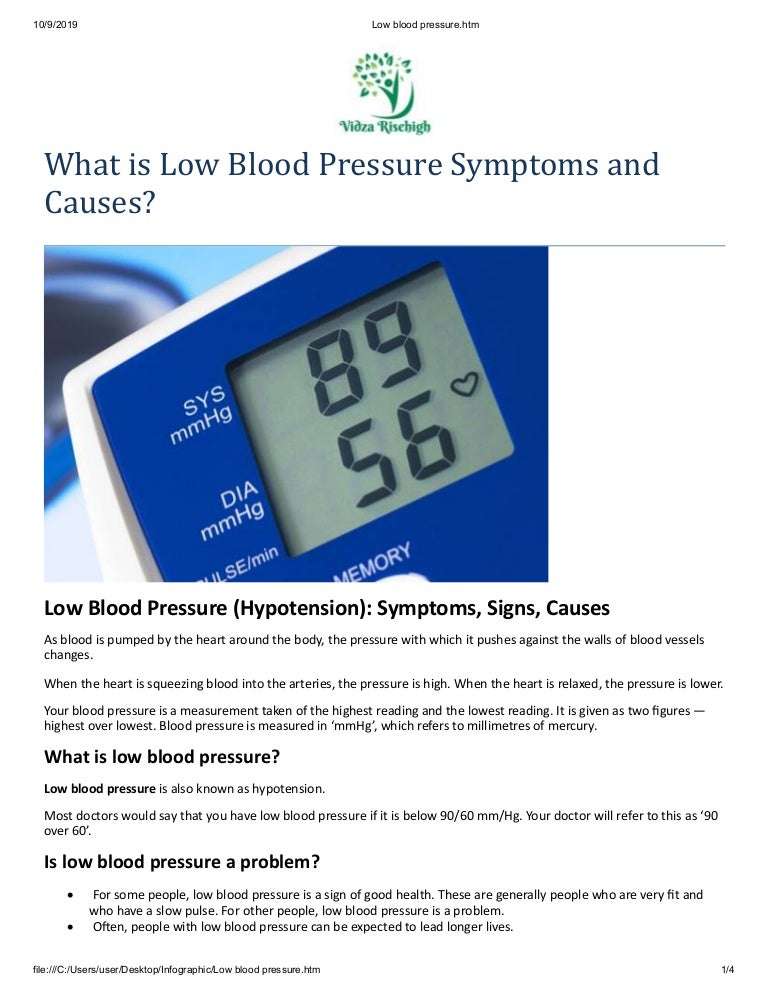Low Blood Pressure In Elderly People: The Vital Facts You Should Know
Most people are aware that high blood pressure in seniors can lead to serious medical issues, but low blood pressure in elderly individuals gets far less attention. However, blood pressure that drops too low can have equally serious effects on your health. It’s important to know the facts so that you can take proper care of yourself.
A low blood pressure reading is not necessarily cause for panic. While high blood pressure is harmful even if you don’t know you have it, low blood pressure is generally not a problem unless you start experiencing symptoms like dizziness or blurred vision. If that happens, you need to take action. Symptomatic low blood pressure in the elderly can be very dangerous because it raises the risk of a fall. At its most extreme, it can lead to shock and even death.
This article explains the basic facts about blood pressure, including how it’s measured and what the measurements mean. It also describes common symptoms of low blood pressure and outlines a variety of factors that can cause such a condition. And it provides information about different ways that low blood pressure in older adults can be treated or managed.
Prevention And Management Of Low Diastolic Blood Pressure
There are some things you can do to help prevent and manage low diastolic pressure:
- Try to keep your salt intake to between 1.5 and 4 grams per day. An ideal number is about 3.5 grams. Read food labels to avoid added salt in your diet.
- Eat a heart-healthy diet. This diet includes plenty of fruits, vegetables, and whole grains. For protein, stick to lean meats and fish. Avoid fatty foods.
- Drink enough fluids and avoid alcohol, which can increase your risk of dehydration.
- Stay physically active and start an exercise program. Ask your doctor what type and amount of exercise is safe for you.
- Maintain a moderate weight. If youre overweight, your doctor can help you create a safe weight loss plan.
- If you smoke, quit. Quitting can be difficult, so consider reaching out for support.
Diagnosis For Low Blood Pressure
Your doctor will check your blood pressure and then ask you questions about any episodes youve experienced to find out if low blood pressure is the cause. Blood work or urinalysis can also provide results that indicate low blood pressure.
If your doctor suspects that another medical condition is lowering your blood pressure, youll need to complete more specific tests to learn more. If another condition is discovered, treating it can have a positive impact on your blood pressure.
Read Also: Blood Pressure Side Effects
How To Raise Low Blood Pressure
If youre dealing with hypotension, the first step is making an appointment with your doctor. After discussing your medical history, lifestyle, and other factors, your doctor may change your medication or suggest certain lifestyle changes to get to the root of the issue.
Its important not to stop taking any medications or change dosages without talking to a healthcare professional first. The same is true of dietary or other changes.
Q What Should You Eat When Experiencing Low Blood Pressure

- Drinking plenty of fluids- hydration is key, and dehydration can severely affect blood volume.
- Drink plenty of water through the day, especially after a workout session.
- Vitamin B12- lack of vitamin B12 can lead to anemia. So, you have to consume foods like eggs, cereals, and beef to avoid a dip in your blood pressure.
- Folate- folate helps keep blood pressure levels at a steady level, and foods like asparagus, liver, and garbanzo beans are rich in folate.
- Salt: Salty foods are known to increase blood pressure, and you can eat food like smoked fish, cottage cheese, canned soup, and olives.
- Caffeine: Caffeinated tea and coffee can spike your blood pressure by stimulating the cardiovascular system and giving your rate a boost.
Read Also: How To Calibrate Omron Blood Pressure Machine
What Should I Do If My Blood Pressure Is 160 Over 100
Your doctor If your blood pressure is higher than 160/100 mmHg, then three visits are enough. If your blood pressure is higher than 140/90 mmHg, then five visits are needed before a diagnosis can be made. If either your systolic or diastolic blood pressure stays high, then the diagnosis of hypertension can be made.
Symptoms Of Low Blood Pressure In Elderly Individuals
As long as you feel OK, a low blood pressure reading is generally nothing to worry about. Doctors are not usually concerned about a low BP in otherwise healthy individuals.
So, when is blood pressure too low? You should see your healthcare provider if you experience hypotension symptoms such as:
- Dizziness
- Confusion or inability to concentrate
- Nausea
- An irregular or rapid heartbeat
- Weakness
Read Also: Does Omron Blood Pressure Monitor Need Calibration
Regulation Of Blood Pressure
The endogenous, homeostatic regulation of arterial pressure is not completely understood, but the following mechanisms of regulating arterial pressure have been well-characterized:
These different mechanisms are not necessarily independent of each other, as indicated by the link between the RAS and aldosterone release. When blood pressure falls many physiological cascades commence in order to return the blood pressure to a more appropriate level.
What Are The Side Effects Of The Treatment For Low Blood Pressure
There are no side effects for the lifestyle and dietary changes that can treat hypotension.
The medications used to treat hypotension have several side effects, some of which may be serious. Fludrocortisone can make certain infections worse, so its essential to discuss this medication with your doctor. The most common side effects from fludrocortisone are:
- Increased risk of infection.
The most common side effects from midodrine are:
- Numbness or tingling.
- Goosebumps and chills.
Don’t Miss: Can Apple Watch Tell Your Blood Pressure
Low Blood Pressure Symptoms
Low blood pressure is pressure so low it causes symptoms or signs due to the low flow of blood through the arteries and veins. When the flow of blood is too low to deliver enough oxygen and nutrients to vital organs such as the brain, heart, and kidney, the organs do not function normally and may be temporarily or permanently damaged.
Unlike high blood pressure, low blood pressure is defined primarily by signs and symptoms of low blood flow and not by a specific blood pressure number. Some individuals routinely may have blood pressure numbers of 90/50 with no symptoms and therefore do not have low blood pressure. However, others who normally have higher blood pressures may develop symptoms of low blood pressure if their blood pressure drops to 100/60.
During pregnancy, blood pressure tends to decrease. Normal blood pressure during pregnancy may be lower than 100/60. Your OB/GYN or Midwife should monitor your bood pressure if you are pregnant.
What To Do When Your Blood Pressure Drops Too Low & How To Raise It
Maintaining ideal blood pressure can be a difficult task for some. As very high as well as low blood pressure levels can be dangerous, it is necessary to maintain the normal range. So, while a healthy routine and medications are important for high blood pressure, it is also essential to know about the symptoms of very low blood pressure. Let us understand what to do when your blood pressure drops too low and how to raise it.
Don’t Miss: Vinegar And High Blood Pressure
Medications May Cause Low Blood Pressure
Medications used to treat conditions other than low blood pressure may cause low blood pressure as a side effect. Erectile dysfunction medications such as sildenafil , tricyclic antidepressants such as amitriptyline , and Parkinsons medications such as levodopa-carbidopa , are a few medications whose side effects may include low blood pressure. Narcotic pain medications and alcohol also decrease blood pressure.
When blood pressure medications work too well, low blood pressure may result. Angiotensin-receptor blockers , calcium channel blockers , beta blockers, and diuretics are some types of blood pressure medications.
Also Check: What Animal Has The Highest Blood Pressure
What Are Treatments For Low Blood Pressure

According to Dr. Laffin, If youre underweight, working to healthfully increase your weight and muscle mass will help to increase your blood pressure.
Dr. Laffin also recommends the following:
- Hydrate often to prevent dehydration. When youre dehydrated, your blood volume drops and, as a result, so does your blood pressure. Drinking adequate fluids increases the volume of your blood. Remember to drink before youre thirsty, which is often a sign that youre already dehydrated.
- Eat multiple small meals throughout the day instead of three large ones. This prevents too much blood flowing to your gut to aid in digestion.
- Get up from a seated or lying position gradually rather than bolting upright.
- Take blood pressure lowering medications at night. Most BP medications last 24-hours, but the peak effect occurs two to three hours after we take them. If taken at night, this will be while youre sleeping and help you to avoid your blood pressure getting too low while youre awake.
- Avoid very hot showers or visiting saunas, hot tubs, or steam rooms. They dilate blood vessels, causing blood pressure to drop.
Don’t Miss: What Causes Irregular Blood Pressure
Effective Home Remedies For Low Blood Pressure
- NDTV Food
While you may have heard of hypertension or high blood pressure, suffering from low blood pressure can be as dangerous as well. An optimal blood pressure reading is less than 120mm Hg and above 80 mm Hg. The first number indicates the systolic pressure or the pressure in the arteries when the heart beats and fills with them with blood. The second number represents the diastolic pressure which is the pressure in the arteries when the heart rests between beats. Low blood pressure or hypotension may cause inadequate blood flow to the heart, brain, and other vital organs. A sudden drop in blood pressure often occurs when someone suddenly rises from a lying down or sitting position. This is called postural hypo-tension and may cause light-headedness and dizziness. There are some home remedies for low blood pressure that you can employ in order to deal with the symptoms of erratic blood pressure. But if youve been feeling the following symptoms for a while, consult your doctor and get your blood pressure measured
- Fatigue
- Loss of consciousness
- Blurry vision
Once your doctor confirms that your blood pressure is low, follow his advice and take medication if required. A healthy low blood pressure diet is important for low blood pressure treatment. Along with that, heres more homely help. Your diet plays a crucial role in maintaining your blood pressure.
What Does Low Blood Pressure Feel Like
The heart is a very strong pump which pumps the blood to all around the body through blood vessels. The blood exerts a force on the vessel wall, and blood pressure is a measure of this force. The normal range of blood pressure is between 90/60 mmHg to 140/90 mmHg. When the blood pressure falls below 90/60 mmHg, it is regarded as low blood pressure.
Also Check: Side Effects Of Blood Pressure
Tips For Clients With Low Blood Pressure
Drink more fluids Fluids help keep blood volume at a normal level. Sports drinks, due to their higher levels of electrolytes like potassium and sodium, may be more beneficial than plain water in this case.Salt Adding salt to her diet can help increase fluid retention in the blood vessels which can normalize her blood pressure.Smaller and more frequent meals Large meals can shunt blood to the digestive system in may lower blood pressure in the short term.Coffee Research shows that 200-250 mgs of caffeine can decrease postural hypotension.Support hose Support hose help reduce pooling of blood in the lower legs, which means theres more blood left in the upper body to maintain blood pressure.
As I always recommend, your first choice for exercise advice should come from your clients physician. Not only does this cover you legally, but it also shows both the physician and your client that you are concerned about her well being. Youll find that the client and the physician will then be great referral sources. It also enhances your credibility as a professional in the health care chain.
The physician will also be able to rule out conditions such as diabetes, cardiovascular disorders, alcoholism, neuropathy, central nervous system disorders and pregnancy, which can lead to changes in blood pressure.
Read Also: Does Alcohol Affect Your Blood Pressure
Changing The Diameter Of Arterioles And Veins
Muscle tissue within the walls of arterioles allow these blood vessels to widen or narrow . The more constricted arterioles are, the greater their resistance to blood flow and the higher the blood pressure. Constriction of arterioles increases blood pressure because more pressure is needed to force blood through the narrower space. Conversely, dilation of arterioles reduces resistance to blood flow, thus reducing blood pressure. The degree to which arterioles are constricted or dilated is affected by
-
Nerves that contract smooth muscle in the arterioles, thus reducing their diameter
-
Hormones Endocrine Function The main function of endocrine glands is to secrete hormones directly into the bloodstream. Hormones are chemical substances that affect the activity of another part of the body … read more that are primarily made by the kidneys
-
Certain drugs
Veins also play a role in the control of blood pressure, although their effect on blood pressure is much less than that of arterioles. Veins dilate and constrict to change how much blood they can hold . When veins constrict, their capacity to hold blood is reduced, allowing more blood to return to the heart from which it is pumped into the arteries. As a result, blood pressure increases. Conversely, when veins dilate, their capacity to hold blood is increased, allowing less blood to return to the heart. As a result, blood pressure decreases.
Recommended Reading: Can High Blood Pressure Cause Nerve Damage
What Causes Low Blood Pressure
The cause of low blood pressure isn’t always clear. It may be associated with the following:
- Pregnancy
- Severe dehydration from vomiting, diarrhea, or fever
- A reaction to medication or alcohol
- A severe allergic reaction called anaphylaxis that causes an irregular heartbeat
Who Gets Postural Hypotension?
Postural hypotension, which is low blood pressure when standing up suddenly, can happen to anyone for a variety of reasons, such as dehydration, lack of food, or being overly fatigued. It can also be influenced by genetic make-up, aging, medication, dietary and psychological factors, and acute triggers, such as infection and allergy.
Postural hypotension occurs most frequently in people who are taking drugs to control high blood pressure . It can also be related to pregnancy, strong emotions, hardening of the arteries , or diabetes. The elderly are particularly affected, especially those who have high blood pressure or autonomic nervous system dysfunction.
Hypotension after meals is a common cause of dizziness and falls after eating. This is most common after large meals containing a lot of carbohydrates. Itâs believed to be caused by blood pooling into the vessels of the stomach and intestines.
Several drugs are commonly associated with postural hypotension. These medications can be divided into two major categories:
Common causes of naturally occurring postural hypotension include:
Certain diseases can also cause postural hypotension. These include:
Who Gets Low Blood Pressure
Low blood pressure can affect anyone, but the elderly are the most affected population. In fact, many older adults take medication to treat high blood pressure and experience the side effect of their blood pressure dropping too low.
Healthy, active adults and high-level athletes often have lower blood pressure.
Women are also likely to experience low blood pressure in the first 24 weeks of pregnancy.
Read Also: High Blood Pressure And Vinegar
How Is Blood Pressure Generated
The left lower chamber of the heart receives oxygenated blood from the lungs and pumps it throughout the body. The heart fills with blood between heartbeats. This phase in the heart cycle is called diastole. When the heart pumps to push blood throughout the arteries, this phase is called systole. You can place your fingers on your neck or the inside of your wrist to detect your heartbeat. The pulse you feel is the contraction of the hearts left ventricle.
Monitoring And Controlling Blood Pressure

Baroreceptors are specialized cells located within arteries that act as blood pressure sensors. Those in the large arteries of the neck and chest are particularly important. When baroreceptors detect a change in blood pressure, they trigger the body to react to maintain a steady blood pressure. Nerves carry signals from these sensors and the brain to
-
The heart, which is signaled to change the rate and force of heartbeats . This change is one of the first, and it corrects low blood pressure quickly.
-
The arterioles, which are signaled to constrict or dilate .
-
The veins, which are signaled to constrict or dilate .
-
The kidneys, which are signaled to change the amount of fluid excreted and to change the amount of hormones that they produce . This change takes a long time to produce results and thus is the slowest mechanism for how the body controls blood pressure.
Nonetheless, the ways that the body can monitor and control blood pressure have limitations. For example, if a person loses a lot of blood quickly, the body cannot compensate quickly enough, blood pressure falls, and organs may begin to malfunction .
In addition, as people age, the body responds to changes in blood pressure more slowly.
You May Like: Vinegar For Blood Pressure